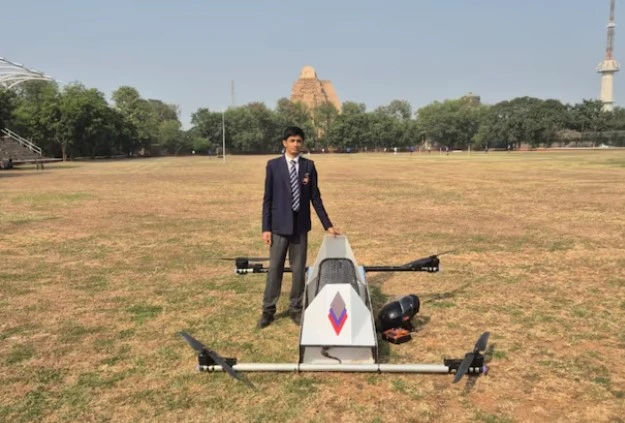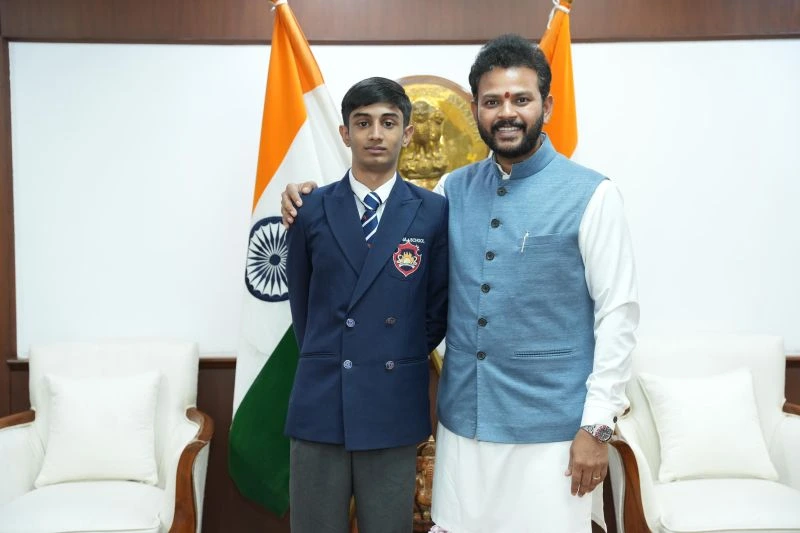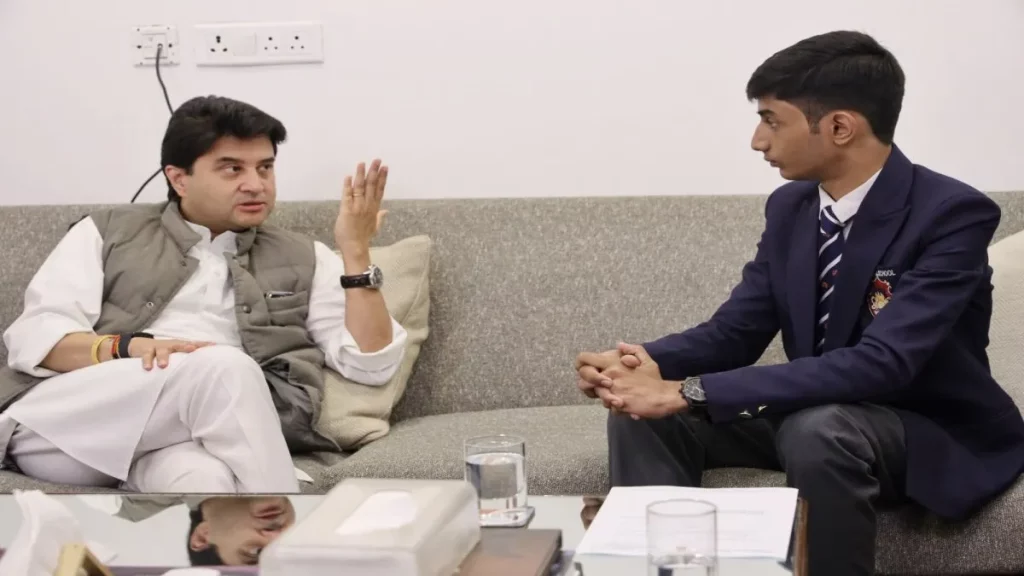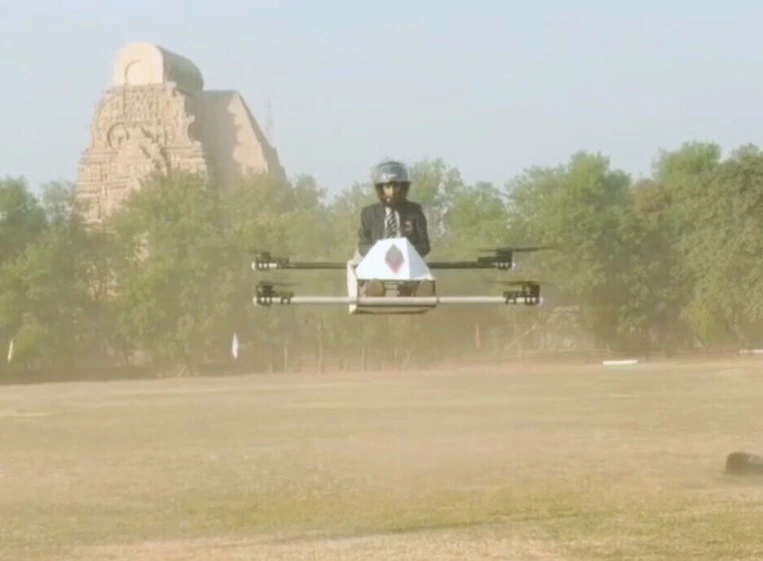(February 1, 2025) At just 17 years old, Medhansh Trivedi has achieved what even seasoned engineers might find daunting—designing and building a single-seater, human-carrying drone in just three months. Named MLDT 01, the drone can lift up to 80 kg and cruise at a speed of 60 kmph. This innovation is not just an impressive feat of engineering but also a glimpse into India’s potential to revolutionise aerial mobility.
A vision inspired by China’s drone revolution
Medhansh, a Class 12 student at the Scindia School in Gwalior, was fascinated by China’s advancements in drone technology. This curiosity soon turned into an ambition when he decided to create a prototype of his own.

Medhansh Trivedi
“I got the inspiration to make this drone after seeing the drones in China. My teacher Manoj Mishra has helped me a lot technically along with providing motivation to develop the drone,” Medhansh said in a statement issued from his school.
Costing just ₹3.5 lakh, MLDT 01 is a 45-horsepower drone that can remain airborne for six minutes. Though currently limited to flying at a height of 10 meters for safety reasons, its four motors, similar to those used in agricultural drones, give it the potential for more advanced applications. Medhansh is determined to upgrade it into a hybrid model in the future, expanding its uses to agriculture, goods transportation, and even human mobility.
Earning recognition from India’s top leaders
Medhansh’s innovation has caught the attention of some of the most influential figures in the country. Minister of Civil Aviation Ram Mohan Raju Kinjarapu was deeply impressed, and stated, “Interacting with Medhansh and hearing his vision left me inspired and confident about India’s bright future in technology and innovation. His aspiration to use drones for practical applications like transporting individuals and goods highlights the transformative potential of such creations in addressing real-world challenges.”


Medhansh Trivedi with Minister of Civil Aviation Ram Mohan Raju Kinjarapu
It is not just political leaders who have taken notice. Business magnate Anand Mahindra also acknowledged the young innovator’s achievement, saying: “It’s not so much about innovation, since the know-how of building such a machine is available on the net. It’s about the passion for engineering and the commitment to get the job done. The more the young people we have like this, the more innovative a nation we will become.”
Furthermore, none other than former ISRO Chief S. Somanath lauded Medhansh’s efforts, recognising the significance of such innovations in advancing India’s aerospace sector.
The Scindia School legacy: Nurturing innovators
Medhansh is a product of the Scindia School, a historic institution in Gwalior that has long been known for fostering leadership and innovation. Over the years, this school has produced several luminaries who have made significant contributions to India’s development across various sectors. The institution’s emphasis on research and practical learning played a crucial role in Medhansh’s journey.


Medhansh with Union Minister Jyotiraditya Scindia
Union Minister Jyotiraditya Scindia, an alumnus and patron of the school, personally met with Medhansh to congratulate him. He encouraged the young innovator to view his creation as the beginning of something bigger.
“I met Medhansh Trivedi and congratulated him for his innovation. I have assured him of all possible help to ensure his bright future,” Scindia said.
The minister further advised Medhansh to prepare himself for studying in the world’s top institutions, promising his full support in shaping the young innovator’s future.
The road ahead: Air taxis and beyond
Medhansh’s ambition does not stop at this one drone. Looking ahead, he envisions a future where air taxis are a common mode of transport. “In future, I will make drones useful for common people which can be used to carry goods, transport a person to another place, and in agriculture,” he stated.
His ultimate goal? To establish an air taxi company and develop an affordable helicopter that can make aerial mobility accessible to the masses.
A knack for innovation from an early age
Medhansh’s journey toward becoming an innovator started long before MLDT 01 took flight. His teacher, Manoj Mishra, recalls how the young prodigy exhibited an inclination towards creativity and engineering from as early as Class 7.
“With the aim of doing something different, he used to take information about new inventions. I also make models myself. After seeing these models and after seeing the human carrying drone of China, he got inspired to make this drone,” Mishra explained.


Medhansh Trivedi
India and China: A race in drone technology
Medhansh’s innovation comes at a time when drone technology is rapidly evolving across the globe. China has been a dominant force in this sector, with companies like DJI leading the way in consumer and industrial drones. The country has leveraged drone technology for agriculture, logistics, and even aerial taxis in cities like Shenzhen.
India, meanwhile, is catching up. The government has introduced several policies to encourage the domestic drone industry, such as the Production-Linked Incentive (PLI) scheme. Startups and young innovators like Medhansh are proving that India has the potential to emerge as a leader in this field. With the right support and investment, innovations like MLDT 01 could pave the way for a new era of aerial transportation.
A sky full of possibilities
Medhansh Trivedi’s journey from being an inspired student to an innovator has been nothing short of extraordinary. His human-carrying drone is a symbol of India’s growing potential in aerospace technology.
With recognition from industry leaders, encouragement from government officials, and the power of his own ambition, Medhansh is poised to take his innovations to new heights. If MLDT 01 is just the beginning, then the future of aerial transportation in India looks incredibly promising.
Read More Fascinating Stories




